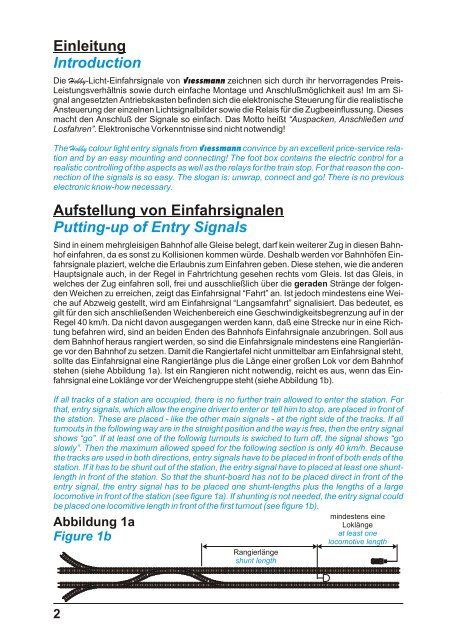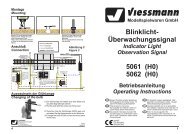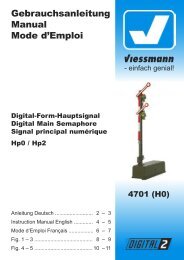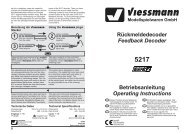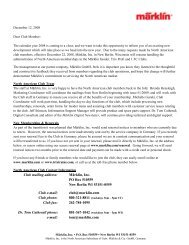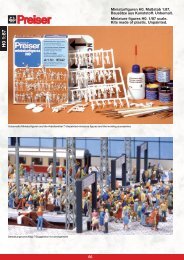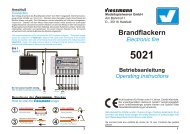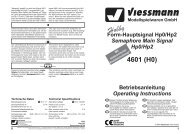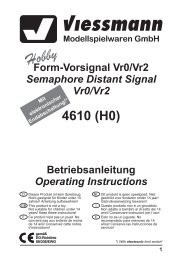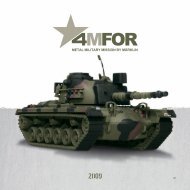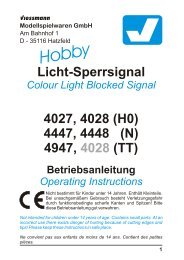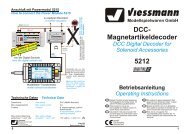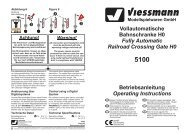Licht-Einfahrsignal 4022 (H0) 4442 (N) 4942 (TT)
Licht-Einfahrsignal 4022 (H0) 4442 (N) 4942 (TT)
Licht-Einfahrsignal 4022 (H0) 4442 (N) 4942 (TT)
Erfolgreiche ePaper selbst erstellen
Machen Sie aus Ihren PDF Publikationen ein blätterbares Flipbook mit unserer einzigartigen Google optimierten e-Paper Software.
Einleitung<br />
Introduction<br />
Die Hobby-<strong>Licht</strong>-<strong>Einfahrsignal</strong>e von Viessmann zeichnen sich durch ihr hervorragendes Preis-<br />
Leistungsverhältnis sowie durch einfache Montage und Anschlußmöglichkeit aus! Im am Signal<br />
angesetzten Antriebskasten befinden sich die elektronische Steuerung für die realistische<br />
Ansteuerung der einzelnen <strong>Licht</strong>signalbilder sowie die Relais für die Zugbeeinflussung. Dieses<br />
macht den Anschluß der Signale so einfach. Das Motto heißt “Auspacken, Anschließen und<br />
Losfahren”. Elektronische Vorkenntnisse sind nicht notwendig!<br />
The Hobby colour light entry signals from Viessmann convince by an excellent price-service relation<br />
and by an easy mounting and connecting! The foot box contains the electric control for a<br />
realistic controlling of the aspects as well as the relays for the train stop. For that reason the connection<br />
of the signals is so easy. The slogan is: unwrap, connect and go! There is no previous<br />
electronic know-how necessary.<br />
Aufstellung von <strong>Einfahrsignal</strong>en<br />
Putting-up of Entry Signals<br />
Sind in einem mehrgleisigen Bahnhof alle Gleise belegt, darf kein weiterer Zug in diesen Bahnhof<br />
einfahren, da es sonst zu Kollisionen kommen würde. Deshalb werden vor Bahnhöfen <strong>Einfahrsignal</strong>e<br />
plaziert, welche die Erlaubnis zum Einfahren geben. Diese stehen, wie die anderen<br />
Hauptsignale auch, in der Regel in Fahrtrichtung gesehen rechts vom Gleis. Ist das Gleis, in<br />
welches der Zug einfahren soll, frei und ausschließlich über die geraden Stränge der folgenden<br />
Weichen zu erreichen, zeigt das <strong>Einfahrsignal</strong> “Fahrt” an. Ist jedoch mindestens eine Weiche<br />
auf Abzweig gestellt, wird am <strong>Einfahrsignal</strong> “Langsamfahrt” signalisiert. Das bedeutet, es<br />
gilt für den sich anschließenden Weichenbereich eine Geschwindigkeitsbegrenzung auf in der<br />
Regel 40 km/h. Da nicht davon ausgegangen werden kann, daß eine Strecke nur in eine Richtung<br />
befahren wird, sind an beiden Enden des Bahnhofs <strong>Einfahrsignal</strong>e anzubringen. Soll aus<br />
dem Bahnhof heraus rangiert werden, so sind die <strong>Einfahrsignal</strong>e mindestens eine Rangierlänge<br />
vor den Bahnhof zu setzen. Damit die Rangiertafel nicht unmittelbar am <strong>Einfahrsignal</strong> steht,<br />
sollte das <strong>Einfahrsignal</strong> eine Rangierlänge plus die Länge einer großen Lok vor dem Bahnhof<br />
stehen (siehe Abbildung 1a). Ist ein Rangieren nicht notwendig, reicht es aus, wenn das <strong>Einfahrsignal</strong><br />
eine Loklänge vor der Weichengruppe steht (siehe Abbildung 1b).<br />
If all tracks of a station are occupied, there is no further train allowed to enter the station. For<br />
that, entry signals, which allow the engine driver to enter or tell him to stop, are placed in front of<br />
the station. These are placed - like the other main signals - at the right side of the tracks. If all<br />
turnouts in the following way are in the streight position and the way is free, then the entry signal<br />
shows “go”. If at least one of the followig turnouts is swiched to turn off, the signal shows “go<br />
slowly”. Then the maximum allowed speed for the following section is only 40 km/h. Because<br />
the tracks are used in both directions, entry signals have to be placed in front of both ends of the<br />
station. If it has to be shunt out of the station, the entry signal have to placed at least one shuntlength<br />
in front of the station. So that the shunt-board has not to be placed direct in front of the<br />
entry signal, the entry signal has to be placed one shunt-lengths plus the lengths of a large<br />
locomotive in front of the station (see figure 1a). If shunting is not needed, the entry signal could<br />
be placed one locomitive length in front of the first turnout (see figure 1b).<br />
Abbildung 1a<br />
Figure 1b<br />
2<br />
Rangierlänge<br />
shunt length<br />
mindestens eine<br />
Loklänge<br />
at least one<br />
locomotive length


